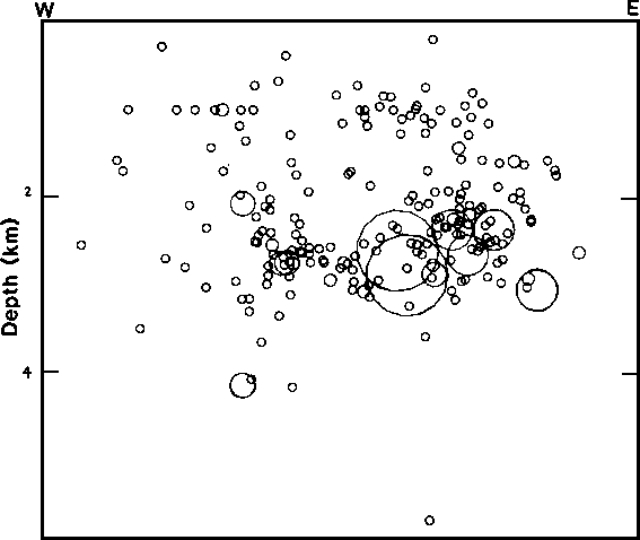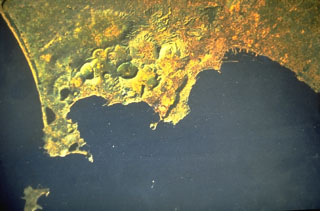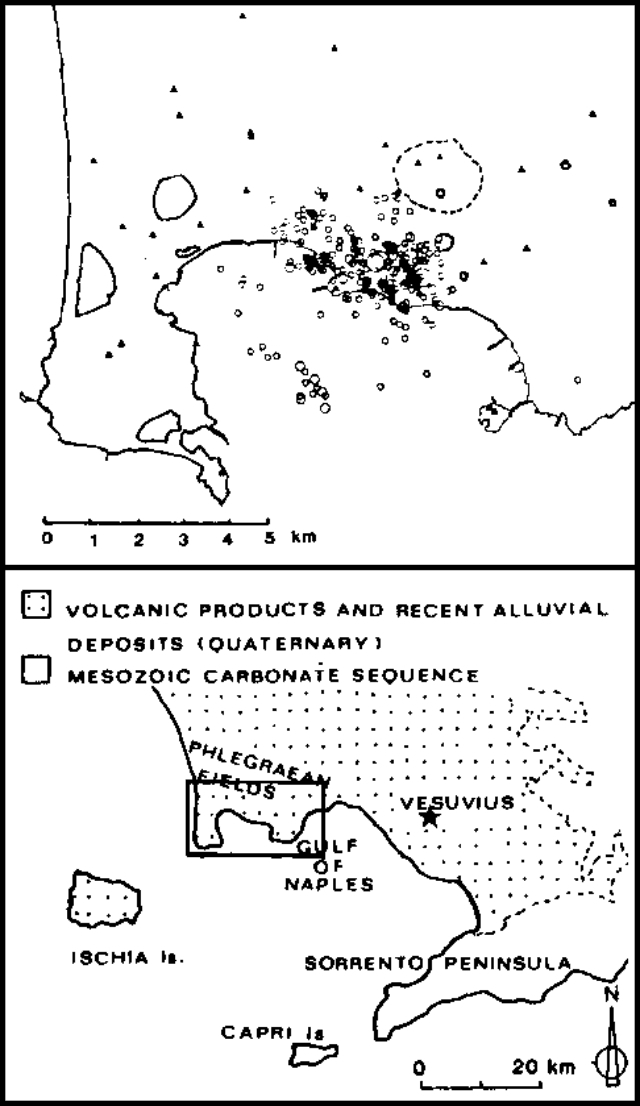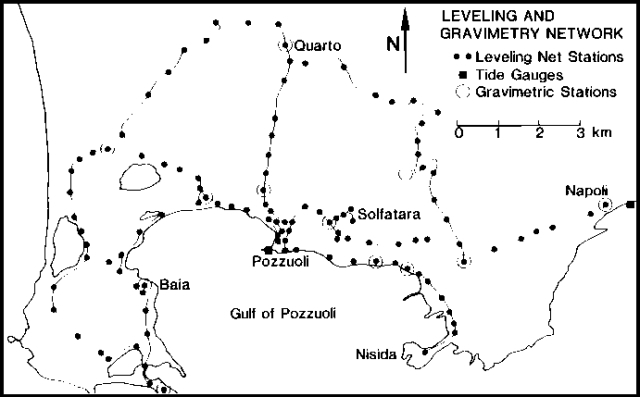Report on Campi Flegrei (Italy) — January 1984
Scientific Event Alert Network Bulletin, vol. 9, no. 1 (January 1984)
Managing Editor: Lindsay McClelland.
Campi Flegrei (Italy) Uplift and seismicity in the caldera since mid-1982
Please cite this report as:
Global Volcanism Program, 1984. Report on Campi Flegrei (Italy) (McClelland, L., ed.). Scientific Event Alert Network Bulletin, 9:1. Smithsonian Institution. https://doi.org/10.5479/si.GVP.SEAN198401-211010
Campi Flegrei
Italy
40.827°N, 14.139°E; summit elev. 458 m
All times are local (unless otherwise noted)
"Campi Flegrei has been the site of slow vertical movements since at least Roman times. A slow subsidence had occurred since the last eruption in 1538. An uplift observed in 1970 continued until 1972 without significant seismic activity. The inferred maximum uplift with respect to previous levellings was 170 cm. Slow ground oscillations observed between 1972 and 1982 had an annual period with a range of about 10-15 cm/year in the zone of maximum uplift. Since the summer of 1982 oscillation has not reversed as in previous years. The overall uplift amounted to 110 cm between January 1982 and December 1983 in the zone of maximum movement, within the town of Pozzuoli in the center of the caldera. Repeated levelling surveys in the area have given evidence of an area of uplift of about 6 km radius with a fairly circular symmetry.
"In November 1982 moderate seismic activity was observed by the permanent seismic network that has been operating since 1972 (figure 1). The level of activity was slightly above the microseismic background in the area. In January 1983, public officials were notified of the anomalous trend of the phenomenon and the possibility of increasing seismic and volcanic hazard. In March, a distinct increase in seismic activity was observed with the first M 3 earthquake. Since then, ground uplift has continued with a velocity that reached 5 mm/day during October. After October, oscillations in the rate of uplift were observed, with a range between 1 and 4 mm/day. The seismic activity increased, following a trend similar to that of the uplift velocity. A M 4 earthquake occurred on 4 October when the rate of uplift reached 5 mm/day. This earthquake caused some building collapses (without injuries) in the town of Pozzuoli. Downtown Pozzuoli was evacuated after this event because of concern about the increasing seismic hazard. The main part of the town is built of old brick houses that were increasingly affected by the continuous seismic activity. On 13 October a seismic swarm of >250 shocks occurred in 5 hours. Maximum magnitude was 3.0.
"The people evacuated from Pozzuoli were temporarily resettled in the resort areas surrounding Campi Flegrei. A new settlement has already been planned on the border of the more vulnerable area. The choice of its location was made by public authorities to minimize the social consequences of evacuating people from their residences. The new settlement is relatively safe from a seismic point of view but is not safe from a maximum probable volcanic event.
"The permanent surveillance network operating in the area comprises measurements of ground deformation and seismic activity, and monitoring of gas content and temperatures of fumaroles. Temporary measurements of self-potential have been performed by a French team from the IPG.
"Vertical ground deformation is measured by a repeated levelling of the permanent network (figure 2) and is also checked daily by a tide gauge in Pozzuoli harbor. Measurements are referred to a tide gauge located in the nearest stable place in Naples. Horizontal deformation is also measured on a network covering Campi Flegrei. The data give evidence of a maximum extension of about 40 cm over 4 km, nearly coincident with the area of maximum vertical uplift.
"The permanent seismic network operating in the area is composed of 22 vertical seismometers, eight of which are operated by the Osservatorio Vesuviano (OV) and 14 by the AGIP company for the initial purpose of monitoring seismic activity connected with the geothermal field. Seven AGIP stations and the eight OV stations are cable-connected to a central point in Naples. Routine locations are made on these 15 stations using the HYP071 program. Subsequent analysis of data from all 22 stations is made utilizing the program LQUAKE by R. Crosson. The preliminary velocity model is based on data collected from the geothermal wells in the area. The shallow character of the seismic activity does not give any evidence of a zone of anomalous propagation of S waves. A seismic explosion campaign has been planned in the Gulf of Pozzuoli of to provide information on the deeper structure of the area.
"The earthquakes of higher magnitude are mainly confined within a restricted area under the Solfatara Crater. They are offset with respect to the area of maximum uplift and their mean depth is about 3 km (E-W profile is shown in figure 3). Preliminary focal mechanisms indicate a predominantly tensile field in this area. The data on temporal distribution of earthquakes indicate a swarm-type character. The event of maximum magnitude (4) occurred 4 October 1983 and its epicenter was in the Solfatara area. A close correlation seems to exist between the velocity of uplift and the seismic activity. The more energetic earthquakes seem to coincide with the higher rates of uplift (4-5 mm/day).
 |
Figure 3. Profile (W-E) showing depth distribution of the earthquakes at Campi Flegrei shown in figure 1. Maximum magnitude 4.0. |
"A cross-cooperation with seimologists from the Univ of Wisconsin is under way. A temporary network of ten 3-component stations with high dynamic range has already been deployed in the area and will be operating for some months. A temporary network of 3-component stations was also operated during November 1983 by IPG seismologists.
"Since April 1983, radon measurements have been made in water wells located in the area. The data are still too preliminary to infer any model. We await a prolonged period of measurements to infer what may be the seasonal trend. Temperatures of the Solfatara fumaroles are also continuously monitored. No significant change has been detected.
"Gas monitoring of the Solfatara fumaroles is carried out by several teams from the Universities of of Pisa, Palermo and Florence, both by continuous measurement and periodic sampling. Preliminary data seem to indicate an increase in the energy flux supplied to the deep water table located at 1.2 km depth by the geothermal wells.
"Two detailed surveys of the helium content of the ground have been performed by a team from the Univ of Rome. Order of magnitude variations have been detected in a large area NW of Pozzuoli."
Reference. Nunziata, C., and Rapolla, A., 1981, Interpretation of gravity and magnetic in the Phlegraean Fields Geothermal Area, Naples, Italy: JVGR, v. 9, p.
Geological Summary. Campi Flegrei is a 13-km-wide caldera that encompasses part of Naples and extends to the south beneath the Gulf of Pozzuoli. Episodes of significant uplift and subsidence within the dominantly trachytic caldera have occurred since Roman times. The earliest known eruptive products are dated 47,000 years BP. The caldera formed following two large explosive eruptions, the massive Campanian ignimbrite about 36,000 BP, and the over 40 km3 Neapolitan Yellow Tuff (NYT) about 15,000 BP. Following eruption of the NYT a large number of eruptions originated from widely scattered subaerial and submarine vents. Most activity occurred during three intervals: 15,000-9,500, 8,600-8,200, and 4,800-3,800 BP. The latest eruption were in 1158 CE at Solfatara and activity in 1538 CE that formed the Monte Nuovo cinder cone.
Information Contacts: G. Luongo and R. Scandone, OV; F. Barberi, Univ. di Pisa.



